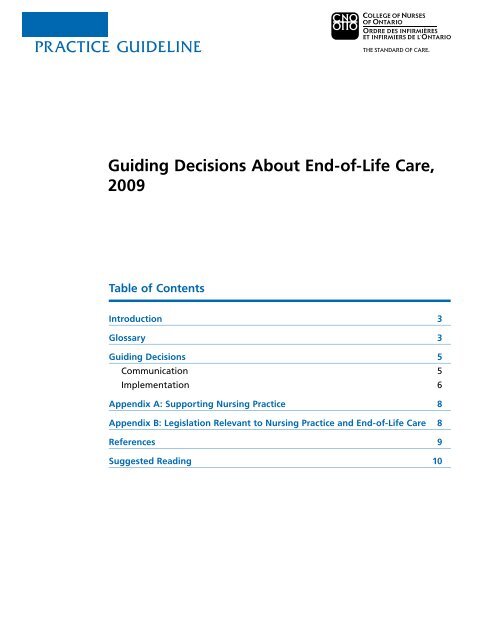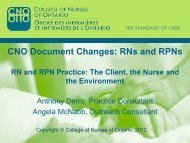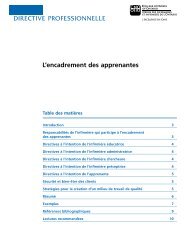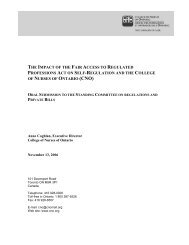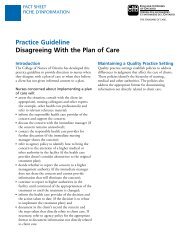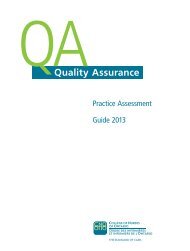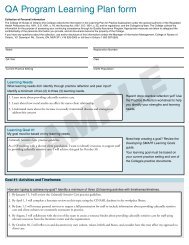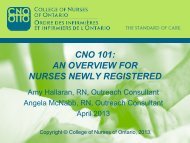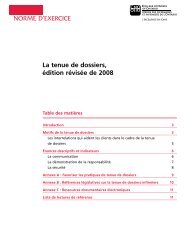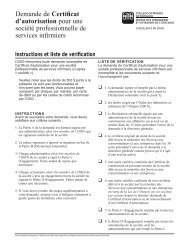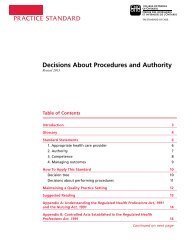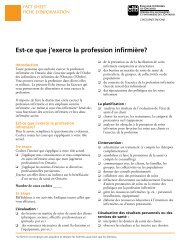Guiding Decisions About End-of-Life Care, 2009 - College of Nurses ...
Guiding Decisions About End-of-Life Care, 2009 - College of Nurses ...
Guiding Decisions About End-of-Life Care, 2009 - College of Nurses ...
Create successful ePaper yourself
Turn your PDF publications into a flip-book with our unique Google optimized e-Paper software.
PRACTICE guideline<strong>Guiding</strong> <strong>Decisions</strong> <strong>About</strong> <strong>End</strong>-<strong>of</strong>-<strong>Life</strong> <strong>Care</strong>,<strong>2009</strong>Table <strong>of</strong> ContentsIntroduction 3Glossary 3<strong>Guiding</strong> <strong>Decisions</strong> 5Communication 5Implementation 6Appendix A: Supporting Nursing Practice 8Appendix B: Legislation Relevant to Nursing Practice and <strong>End</strong>-<strong>of</strong>-<strong>Life</strong> <strong>Care</strong> 8References 9Suggested Reading 10
Practice Guideline3Practice guidelines are documents that help nursesunderstand their responsibilities and legal obligationsto enable them to make safe, effective and ethicaldecisions when practising. They provide an outline <strong>of</strong>pr<strong>of</strong>essional accountabilities and relevant legislation.As self-regulating pr<strong>of</strong>essionals, nurses are responsiblefor practising in accordance with the <strong>College</strong>’s practicedocuments and relevant legislation.– <strong>College</strong> <strong>of</strong> <strong>Nurses</strong> <strong>of</strong> OntarioIntroduction<strong>End</strong>-<strong>of</strong>-life care1 is grounded in the ethicalvalues <strong>of</strong> nursing, which include respecting aclient’s2 choice, well-being and life, maintainingcommitments, and valuing privacy, confidentiality,truthfulness and fairness. The <strong>Guiding</strong> <strong>Decisions</strong><strong>About</strong> <strong>End</strong>-<strong>of</strong>-<strong>Life</strong> <strong>Care</strong>, <strong>2009</strong> practice guidelineaims to help nurses3 understand their roles andresponsibilities when providing end-<strong>of</strong>-life care.The document includes key concepts to help nursesassist clients in making choices and articulatingtheir wishes about treatment such as resuscitationand end-<strong>of</strong>-life care.<strong>Nurses</strong> must keep in mind that euthanasia andassisted suicide are illegal; there is no role for nursesin facilitating these activities.4This guideline helps nurses apply the followingprinciples:■providing clients with support at the end <strong>of</strong> theirlives or in making decisions about end-<strong>of</strong>-life carein any practice setting (such as pediatrics, researchand the community);■supporting informed discussion about caregoals and treatment options by facilitatingcommunication with clients and members <strong>of</strong> theinterpr<strong>of</strong>essional team;■contributing to client well-being and actingin the best interest <strong>of</strong> the client by facilitatingthe implementation <strong>of</strong> the client’s wishes abouttreatment and end-<strong>of</strong>-life care; and■knowing and understanding current legislationrelevant to treatment and end-<strong>of</strong>-life care.This practice guideline replaces the Resuscitation,1999 practice standard. <strong>Nurses</strong> should use thisguideline in conjunction with other <strong>College</strong>documents including the Consent, Ethics andTherapeutic Nurse-Client Relationship, Revised 2006practice documents, as well as the policies andprocedures in place in their work settings.GlossaryAdvance directive. The means used to documentand communicate to a substitute decision-maker aclient’s preferences regarding treatment in the eventthat the client becomes incapable <strong>of</strong> expressingthose wishes.5,6 A client may provide an advancedirective for decisions such as organ donationand resuscitation. <strong>Nurses</strong> should be familiar withlegislation and their organization’s policies about theuse <strong>of</strong> advance directives.Capable. A client is capable when he or she canunderstand the information that is relevant tomaking a decision about treatment, and appreciatethe reasonably predictable consequences <strong>of</strong> adecision or lack <strong>of</strong> decision.<strong>End</strong>-<strong>of</strong>-life care. For the purpose <strong>of</strong> this practicedocument, the term end-<strong>of</strong>-life care refers to thecare that is provided to a client at the end <strong>of</strong>his or her life7. The goal <strong>of</strong> end-<strong>of</strong>-life care isto improve the quality <strong>of</strong> living and dying, andminimize unnecessary suffering. It encompassesthe physical, spiritual, social, psychosocial, cultural1 Bolded words are defined in the glossary that begins on this page.2 In this document, client refers to an individual, family, group or community.3 In this document, nurse refers to a Registered Practical Nurse (RPN), Registered Nurse (RN) and Nurse Practitioner (NP).4 For more information, refer to the <strong>College</strong>’s Ethics practice document at www.cno.org/publications.5 (Canadian <strong>Nurses</strong> Association, 2008)6 (Dunbrack, 2006)7 The definition may vary across organizational and practice environments. There is no legal definition for end-<strong>of</strong>-life.<strong>College</strong> <strong>of</strong> <strong>Nurses</strong> <strong>of</strong> Ontario Practice Guideline: <strong>Guiding</strong> <strong>Decisions</strong> <strong>About</strong> <strong>End</strong>-<strong>of</strong>-<strong>Life</strong> <strong>Care</strong>, <strong>2009</strong>
Practice Guideline5Power <strong>of</strong> attorney for personal care. A legaldocument that gives another person the right toact on the client’s behalf with regards to the client’spersonal decisions, such as housing and health care.Making a power <strong>of</strong> attorney is voluntary; no onecan be forced to make one.Resuscitation. An invasive and immediate lifesavingtreatment that is administered to a clientwho has a sudden unexpected cardiac or respiratoryarrest. It may include basic cardiac life supportinvolving the application <strong>of</strong> artificial ventilation(such as mouth-to-mouth resuscitation andbagging) and chest compression. It may also includeadvanced cardiac life support, such as intubationand the application <strong>of</strong> a defibrillator.Substitute decision-maker. The person who isauthorized to give or refuse consent on behalf <strong>of</strong> anincapable client. The substitute decision-maker maybe a relative or a specially appointed person, such assomeone with power <strong>of</strong> attorney for personal care.15Treatment. For the purpose <strong>of</strong> this practicedocument, treatment relates to options a client mayhave available at or near end <strong>of</strong> life. The Health<strong>Care</strong> Consent Act, 1996 defines a treatment as anyact that is performed for a therapeutic, preventive,palliative, diagnostic, cosmetic or other healthrelatedpurpose, and includes a course or plan<strong>of</strong> treatment. Resuscitation is categorized as atreatment under this Act.Wishes. What a capable person expresses abouttreatment, admission to a care facility or a personalassistance service. Wishes may be expressed in apower <strong>of</strong> attorney, in any written form, orally or inany other manner. The most recent wishes a clientexpresses while he or she is capable prevail over anyearlier wishes the client may have given.16<strong>Guiding</strong> <strong>Decisions</strong>When assisting clients in making choices andarticulating their wishes about end-<strong>of</strong>-lifecare, nurses are guided by two core themes:communication and implementation. Clear andongoing communication between the nurse,client and interpr<strong>of</strong>essional team facilitates theimplementation <strong>of</strong> client wishes about treatment andend-<strong>of</strong>-life care.Communication<strong>Nurses</strong> communicate with clients and members<strong>of</strong> the interpr<strong>of</strong>essional team to guide informeddiscussion about the goals <strong>of</strong> care and treatment.<strong>Nurses</strong> communicate the goals <strong>of</strong> care andtreatment by:a) using pr<strong>of</strong>essional judgment to determine howthe interpr<strong>of</strong>essional team needs to be involvedin discussions about the client’s end-<strong>of</strong>-life carewishes;b) assessing whether the client has sufficient andrelevant information to make an informeddecision17 about treatment and end-<strong>of</strong>-life care,including resuscitation;c) providing an opportunity to discuss, identify andreview the client’s end-<strong>of</strong>-life care wishes;d) identifying the client’s wishes about preferredtreatment and/or end-<strong>of</strong>-life care as early aspossible, while considering the client’s conditionand the degree to which the therapeutic nurseclientrelationship has been established;e) identifying and using appropriatecommunication techniques when discussingtreatment and end-<strong>of</strong>-life issues with the client;f) helping and being involved in client and familydiscussions about treatment and/or end-<strong>of</strong>-lifecare;18,19g) consulting with other health care team membersas required, to identify and resolve treatment15 Refer to the Substitute <strong>Decisions</strong> Act, 1992, at www.e-laws.gov.on.ca.16 Refer to the Health <strong>Care</strong> Consent Act, 1996, at www.e-laws.gov.on.ca.17 For more information, refer to the <strong>College</strong>’s Consent practice document at www.cno.org/publications.18 For more information, refer to the <strong>College</strong>’s Conflict Prevention and Management practice document at www.cno.org/publications.19 For more information, refer to the <strong>College</strong>’s Therapeutic Nurse-Client Relationship, Revised 2006 practice document atwww.cno.org/publications.<strong>College</strong> <strong>of</strong> <strong>Nurses</strong> <strong>of</strong> Ontario Practice Guideline: <strong>Guiding</strong> <strong>Decisions</strong> <strong>About</strong> <strong>End</strong>-<strong>of</strong>-<strong>Life</strong> <strong>Care</strong>, <strong>2009</strong>
6Practice Guidelineand/or end-<strong>of</strong>-life care issues. (For example, anurse could present a client situation during ateam meeting or rounds or include an ethicist onthe care team, if it is appropriate);h) knowing the end-<strong>of</strong>-life care wishes <strong>of</strong> the clientor obtaining that knowledge from:■the client’s direct instructions (which includenon-verbal means);■the client’s advance directive (such as a livingwill or power <strong>of</strong> attorney for personal care);■the substitute decision-maker’s instructions,if the client is incapable; or■documented instructions from anothermember <strong>of</strong> the health care team;i) explaining the client’s wishes to all members <strong>of</strong>the interpr<strong>of</strong>essional care team;j) maintaining records20 <strong>of</strong> client andinterpr<strong>of</strong>essional team communicationsabout treatment and end-<strong>of</strong>-life care decisionsaccording to organizational policies andprocedures as well as the <strong>College</strong>’s Documentationpractice document;k) contributing to ongoing communication aboutend-<strong>of</strong>-life care wishes and implementing theclient’s wishes by:■reviewing the client’s plan <strong>of</strong> treatmentincluding resuscitation wishes as needed orwhen required by organizational policy. (Forexample, in long-term care settings, the reviewcould be part <strong>of</strong> the regular client healthreview);■documenting the relevant information; and■communicating any changes in client’s wishesto the interpr<strong>of</strong>essional team and ensuring thewishes are included in the plan <strong>of</strong> treatment;andl) advocating for the creation or modification<strong>of</strong> practice-setting policies and procedures tosupport client choices during treatment and end<strong>of</strong>-lifecare, based on <strong>College</strong> documents.Implementation<strong>Nurses</strong> advocate for the client and help implementthe client’s treatment and end-<strong>of</strong>-life care wishes.<strong>Nurses</strong> implement a client’s treatment and end-<strong>of</strong>lifecare wishes by:a) ensuring that the creation <strong>of</strong> the plan <strong>of</strong>treatment has involved both the interpr<strong>of</strong>essionalteam and the client, and that the client has giveninformed consent for the plan <strong>of</strong> treatmentbefore implementation;b) acting on behalf <strong>of</strong> the client to help clarify theplans for treatment when:■the client’s condition has changed and it maybe necessary to modify a previous decision;■the nurse is concerned the client may nothave been informed <strong>of</strong> all elements in theplan <strong>of</strong> treatment, including the provision orwithholding <strong>of</strong> treatment;21■the nurse disagrees with the physician’s plan <strong>of</strong>treatment;22 and■the client’s family disagrees with the client’sexpressed treatment wishes;23c) initiating treatment when:■the client’s wish for treatment is knownthrough a plan <strong>of</strong> treatment and informedconsent;■the client’s wish is not known, but a substitutedecision-maker has provided informed consentfor treatment; or■it is an emergency situation, there is noinformation about the client’s wish, and asubstitute decision-maker is not immediatelyavailable;d) not initiating treatment that is not in the plan <strong>of</strong>treatment, except in emergency situations, when:■the client has not given informed consent,and/or the plan <strong>of</strong> treatment does not addressreceiving the treatment;■the incapable client’s wish is not known, andthe substitute decision-maker has indicated20 For more information, refer to the <strong>College</strong>’s Documentation, Revised 2008 practice document at www.cno.org/publications.21 For more information, refer to the <strong>College</strong>’s Consent practice document at www.cno.org/publications.22 For more information, refer to the <strong>College</strong>’s Disagreeing with the Plan <strong>of</strong> <strong>Care</strong> practice document at www.cno.org/publications.23 For more information, refer to the <strong>College</strong>’s Conflict Prevention and Management practice document at www.cno.org/publications.<strong>College</strong> <strong>of</strong> <strong>Nurses</strong> <strong>of</strong> Ontario Practice Guideline: <strong>Guiding</strong> <strong>Decisions</strong> <strong>About</strong> <strong>End</strong>-<strong>of</strong>-<strong>Life</strong> <strong>Care</strong>, <strong>2009</strong>
Practice Guideline7that he or she does not want the client toreceive the treatment;■the attending physician has informed theclient that the treatment will be <strong>of</strong> no benefitand is not part <strong>of</strong> the plan <strong>of</strong> treatment thatthe client has agreed to. In this situation,the nurse is not expected to performlife-sustaining treatment (for example,resuscitation), even if the client or substitutedecision-maker requests it; or■the client exhibits obvious signs <strong>of</strong> death, suchas the absence <strong>of</strong> vital signs plus rigor mortisand tissue decay;e) documenting in a written plan <strong>of</strong> treatmentall information that is relevant to theimplementation <strong>of</strong> the client’s wishes fortreatment at end <strong>of</strong> life;f) following the client’s wish for no resuscitationeven in the absence <strong>of</strong> a physician’s writtendo-not-resuscitate (DNR) order;g) engaging in the following when a client’s death isexpected or unexpected:■identifying whom to notify when the clientdies;■identifying the most appropriate category <strong>of</strong>health care provider to notify the family;■identifying the client’s and family’s culturaland religious beliefs and values about death,and management <strong>of</strong> the body after death;24■identifying whether the family wants to seethe body after death; and■documenting according to policies andprocedures;h) possessing the knowledge, skill and judgment todetermine that death has occurred;i) deciding, if necessary, the category <strong>of</strong> health careprovider that will pronounce the death;j) recognizing that all nurses have the authority topronounce death when clients are expected todie and their plan <strong>of</strong> treatment does not includeresuscitation. While RNs and RPNs do not havethe authority to certify death in any situation,Nurse Practitioners do have the authority tocertify an expected death, except in specificcircumstances;25 andk) advocating for the creation or modification <strong>of</strong>practice-setting policies and procedures on theimplementation <strong>of</strong> clients’ treatment and end-<strong>of</strong>lifecare wishes that are consistent with <strong>College</strong>documents.24 For more information, refer to the <strong>College</strong>’s Culturally Sensitive <strong>Care</strong> practice document at www.cno.org/publications.25 For more information about Nurse Practitioners and medical certificates <strong>of</strong> death, refer to the Nurse Practitioners practice resourcesweb page at www.cno.org/np_pr.<strong>College</strong> <strong>of</strong> <strong>Nurses</strong> <strong>of</strong> Ontario Practice Guideline: <strong>Guiding</strong> <strong>Decisions</strong> <strong>About</strong> <strong>End</strong>-<strong>of</strong>-<strong>Life</strong> <strong>Care</strong>, <strong>2009</strong>
8Practice GuidelineAppendix A: Supporting NursingPracticeAll nurses, including employers, researchers andeducators, must demonstrate the knowledge, skill,judgment and attitude26 required <strong>of</strong> regulatedhealth pr<strong>of</strong>essionals. <strong>Nurses</strong> must also reflectand understand their roles in improving theirpractice settings and advocating for qualitynursing care practices. <strong>Nurses</strong>, nurse employersand organizations have a shared responsibility tocreate safe practice environments in which to deliveroptimal health care.To support safe and effective treatment and end-<strong>of</strong>lifecare practices, nurses in all roles as well as theiremployers, educators and related organizations can:■facilitate nursing staff involvement in developing,implementing and evaluating policies andprocedures, such as helping nurses advocate onbehalf <strong>of</strong> clients;■provide access to evidence-based information;■ensure that staff orientation includes informationabout end-<strong>of</strong>-life care issues relevant to thepractice setting;■help other nurses meet the <strong>College</strong>’s practiceexpectations as well as their organization’spolicies;■support nurses in the development <strong>of</strong> relevantcompetencies;■initiate continual quality improvement activities;■recognize the need for, and facilitate, debriefing asappropriate;■identify and acknowledge nursing excellence inproviding care to clients; and■advocate for ways to implement evidenceinformedpractices.Appendix B: Legislation Relevant toNursing Practice and <strong>End</strong>-<strong>of</strong>-<strong>Life</strong> <strong>Care</strong><strong>Nurses</strong> are expected to practise in accordance withthe <strong>College</strong>’s practice documents as well as relevantlegislation. To make safe and ethical decisions whenproviding end-<strong>of</strong>-life care, it is important for nursesto know and understand current legislation that isrelevant to treatment(s) and end-<strong>of</strong>-life care suchas the Health <strong>Care</strong> Consent Act, 1996 and Substitute<strong>Decisions</strong> Act, 1992.The following are some <strong>of</strong> the major features <strong>of</strong> thelegislation:a) Under the Health <strong>Care</strong> Consent Act, 1996,resuscitation is considered to be a treatment.There is no legal requirement to obtain aphysician’s written, telephone or verbal DNRorder.27b) The Health <strong>Care</strong> Consent Act, 1996 and Substitute<strong>Decisions</strong> Act, 1992 enable a capable person tocreate an advance directive. Through an advancedirective, the person can indicate the kinds <strong>of</strong>treatment he or she would like to be acceptedor rejected in the event that the person becomesincapable. If the person becomes incapable, thesedirectives would be interpreted by the person’ssubstitute decision-maker;c) Under the Health <strong>Care</strong> Consent Act, 1996, a client’swishes about treatment may be expressed in:■a power <strong>of</strong> attorney for personal care;■any written form;■a verbal form; or■any other manner (such as sign language).In addition, a client’s wishes about treatment:■can be changed at any time (nurses mustrespect the most current wishes and ensurethe client has given informed consent for thetreatment choice); and■are to be interpreted by the client’s substitutedecision-maker if the client is found to beincapable; and the wishes do not constituteconsent or refusal <strong>of</strong> consent.2826 For more information, refer to the <strong>College</strong>’s Pr<strong>of</strong>essional Standards, Revised 2002 practice document at www.cno.org/publications.27 Although there is no legal requirement for a DNR order, organizations may have policies and procedures in place to direct nursingpractice.28 Refer to the Health <strong>Care</strong> Consent Act, 1996, at www.e-laws.gov.on.ca.<strong>College</strong> <strong>of</strong> <strong>Nurses</strong> <strong>of</strong> Ontario Practice Guideline: <strong>Guiding</strong> <strong>Decisions</strong> <strong>About</strong> <strong>End</strong>-<strong>of</strong>-<strong>Life</strong> <strong>Care</strong>, <strong>2009</strong>
Practice Guideline9ReferencesCanadian Hospice Palliative <strong>Care</strong> Association.(2002). A model to guide hospice palliative care:Based on national principles and norms <strong>of</strong> practice.Retrieved August 6, <strong>2009</strong>, from http://www.chpca.net/norms-standards/model_to_guide_hpc.html.Canadian <strong>Nurses</strong> Association. (2008). PositionStatement. Providing nursing care at the end <strong>of</strong>life. Retrieved July 10, <strong>2009</strong>, from http://www.cna-aiic.ca/CNA/documents/pdf/publications/PS96_<strong>End</strong>_<strong>of</strong>_<strong>Life</strong>_e.pdf.Dunbrack, J. (2006). Advance care planning: Theglossary project. Retrieved July 10, <strong>2009</strong>, from http://www.hc-sc.gc.ca/hcs-sss/alt_formats/hpb-dgps/pdf/pubs/2006-proj-glos/2006-proj-gloss-eng.pdf.Health Canada. (2002). National planning workshopon end-<strong>of</strong>-life care. Retrieved May 27, <strong>2009</strong>, fromhttp://www.hc-sc.gc.ca/hcs-sss/pubs/palliat/2002-nat-plan-palliat/index-eng.php#introduction.Health Canada. (2007). Canadian strategy onpalliative and end-<strong>of</strong>-life care: Final report.Retrieved May 27, <strong>2009</strong>, from http://www.hc-sc.gc.ca/hcs-sss/pubs/palliat/2007-soin_fin-end_life/intro-eng.php.<strong>College</strong> <strong>of</strong> <strong>Nurses</strong> <strong>of</strong> Ontario Practice Guideline: <strong>Guiding</strong> <strong>Decisions</strong> <strong>About</strong> <strong>End</strong>-<strong>of</strong>-<strong>Life</strong> <strong>Care</strong>, <strong>2009</strong>
10Practice GuidelineSuggested ReadingBritish Medical Association, Resuscitation Council(UK), & Royal <strong>College</strong> <strong>of</strong> Nursing. (2007,October). <strong>Decisions</strong> relating to cardiopulmonaryresuscitation. Retrieved January 8, <strong>2009</strong>, fromhttp://www.resus.org.uk/pages/dnar.htm.Fallis, W.M., McClement, S., & Pereira, A. (2008).Family presence during resuscitation: A survey<strong>of</strong> Canadian critical care nurses practices andperceptions. Dynamics, (19)3, 22-28.Frank, C., Heyland, D.K., Chen, B., Farquhar, D.,Myers, K., & Iwaasa, K. (2003). Determiningresuscitation preferences <strong>of</strong> elderly inpatients:A review <strong>of</strong> the literature. Canadian MedicalAssociation Journal, 169(8), 795-799.Payne, J.K., & Thornlow, D.K. (2008). Clinicalperspectives on portable do-not-resuscitate orders.Journal <strong>of</strong> Gerontological Nursing, 34(10), 11-16.Wahl, J. (2006). Advance care planning: The legalissues. Paper presented at the Canadian Centrefor Elder Law Studies Conference, October2006. Retrieved May 27, <strong>2009</strong>, from http://www.thehealthline.ca/Docs/Advance<strong>Care</strong>Planning_Legal.pdf.Walker, W.M. (2008). Dying, sudden cardiacdeath and resuscitation technology. InternationalEmergency Nursing, 16(2), 119-126.Health Canada Secretariat on Palliative and <strong>End</strong><strong>of</strong>-<strong>Life</strong><strong>Care</strong>. (2002). National action planningworkshop on end-<strong>of</strong>-life care. Retrieved on May 27,<strong>2009</strong>, from http://www.hc-sc.gc.ca/hcs-sss/pubs/palliat/2002-nat-plan-palliat/index-eng.php.Jones, J. (2007). Do not resuscitate: Reflections onan ethical dilemma. Nursing Standard, 21(46),35-39.Murphy, P., & Price, D. (2007). How to avoidDNR miscommunications. Nursing Management,38(3), 17, 20.O’Connor, A.M., & Jacobson, M.J. (2007, May).Decisional conflict: Supporting people experiencinguncertainty about options affecting their health.Retrieved August 11, 2008, from https://decisionaid.ohri.ca/ODST/pdfs/DC_Reading.pdf.Ontario. Ministry <strong>of</strong> Health and Long-Term <strong>Care</strong>.(<strong>2009</strong>). HealthLinks: Organ and tissue donation.Retrieved June 30, <strong>2009</strong>, from http://www.health.gov.on.ca/english/hlinks/donation.html.Ontario. Office <strong>of</strong> the Registrar General. (2001,May). Handbook on medical certification <strong>of</strong> death.Thunder Bay, Ont.: Author. (Available from TheOffice <strong>of</strong> the Registrar General, 189 Red RiverRd., 3rd Floor, Thunder Bay, ON P7B 6L8).<strong>College</strong> <strong>of</strong> <strong>Nurses</strong> <strong>of</strong> Ontario Practice Guideline: <strong>Guiding</strong> <strong>Decisions</strong> <strong>About</strong> <strong>End</strong>-<strong>of</strong>-<strong>Life</strong> <strong>Care</strong>, <strong>2009</strong>
Practice Guideline11Notes:<strong>College</strong> <strong>of</strong> <strong>Nurses</strong> <strong>of</strong> Ontario Practice Guideline: <strong>Guiding</strong> <strong>Decisions</strong> <strong>About</strong> <strong>End</strong>-<strong>of</strong>-<strong>Life</strong> <strong>Care</strong>, <strong>2009</strong>
101 Davenport Rd.Toronto, ONM5R 3P1www.cno.orgTel.: 416 928-0900Toll-free in Ontario: 1 800 387-5526Fax: 416 928-6507E-mail: cno@cnomail.orgDEC <strong>2009</strong>43001<strong>2009</strong>-118


